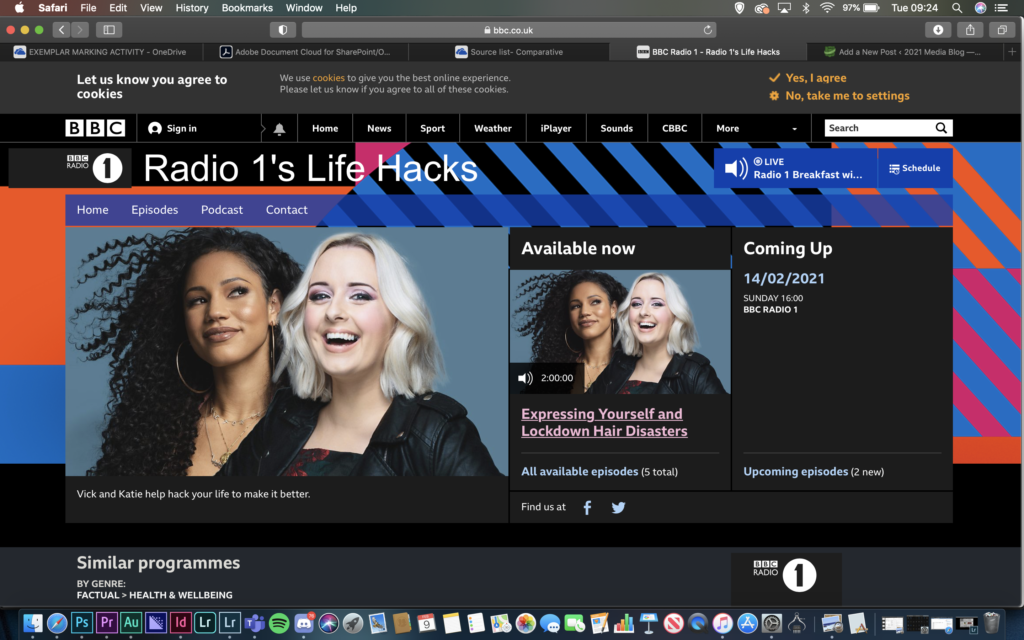Life hack vs war of the worlds, talk about audiences and industry.
Show evidence of listening to the programmes- eg use quotes and textual reference. Do not analyse the programme, just use evidence to support your answer. For example- in the 3rd minute this presenter said… vick and katie
children’s mental health week, how people cope. A lot more inclusive with the audience
BBC- life hacks, PBS made by us for us. Charter, and ethos, to entertain, inform and educate.
Centred around younger audience – episode ‘ expressing yourself and lockdown hair disasters’
Casual talk, rather than scripted, less injecting information more chatty and discussing things, unlike war of the worlds which is hypodermic model where media and radios aim was to inject the mass with certain thoughts. It is more active rather than passive
War of the worlds 1937, technological development things have changed.
PBS- tv licence to pay for this service, minimise risk- ‘media is a risky business’ as hesmondhalgph.
production of culture- should the bbc stay? when it isn’t used just for information and education.
New generations challenge everything are more active.
Curran and seaton- diversification, bbc life hacks cater to everyone but not all at once
Radio is now personal, especially during lock down in the uk.
Essay- decide on what argument and carry through the essay, the value of PBS , we don’t need PBS, technology has changed the way people think. More participatory, interactive( life hacks ask audience to call in and tell stories. As well as online votes which influence what the radio discuss.
Needs to be interesting for people to interact or listen at all.
diversity and representation- PBS everyone is includes, men and women voices, different sounds.(life hacks) where as war of the worlds- older men telling you what i what
More democratic (life hacks) theory of preferred reading as well as uses and gratifications
Structure of my essay- Radio is more democratic- 1930’s Laswell hypothermic model, War of the worlds after he world war audience is passive takes in information and doesn’t challenge it. War of the worlds= aliens attacking the earth
1960 uses and gratification- escapism, uses the media for certain things for example watching a film at a certain time and just being a passive audience.
Stuart hall – preferred reading 1980’s, Encode decode oppose people consume things differently depending on their demographics ( age,race, gender ect..)
Shirky- 2000’s , theory of end of audience, audience is now proactive no longer passive. Can interact with publishers and producers , more of a ‘community’ people can now “talk back”. people can share comment like different things. Thanks to twitter people can put their input into productions and tell the producers what they like and dislike. For example life hacks is more interactive and is less top down but more of a flat hierarchy. People can interact with the radio as they can call in, suggest songs, chat with the host, vote for certain things.Things have change dramatically due to technology. For example ‘ 14.51, Vik and Katie introduce Racheal a listener about the silliest thing they have done’ Connecting and supporting people ‘ your not alone’. PBS- is made for the people by the people and is now used especially during the global pandemic. 81199 is announced to text in to the show to be included.
BBC- provides for all, allows people to have a voice, rather than dominating one overall message or certain things for profit, BBC is a non profit organisation.
War of the worlds is produced by the CBS radio network. Talking about the aftermath of an invasions by Martians on earth. The producer proceeds to say “Is there anyone on the air? Isn’t there… anyone?” with no response in the first section of the broadcast – this made people believe that this broadcast was real, and not a science fiction.


